 |
||
|
||
| ||
Performance testsTestbed
Benchmarks
Note that performance charts are located on dedicated pages, because they don't fit a reasonable resolution. S.T.A.L.K.E.R.Performance charts: S.T.A.L.K.E.R. 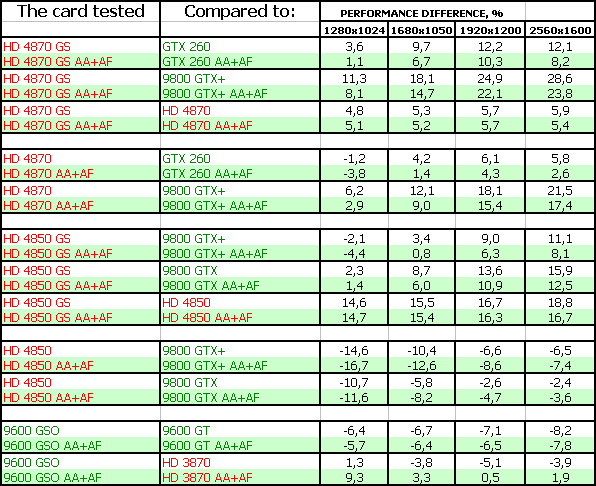 World In ConflictPerformance charts: World In Conflict 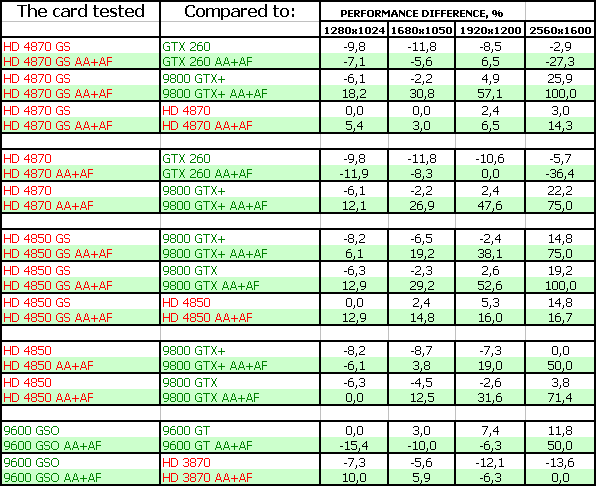 Call Of Juarez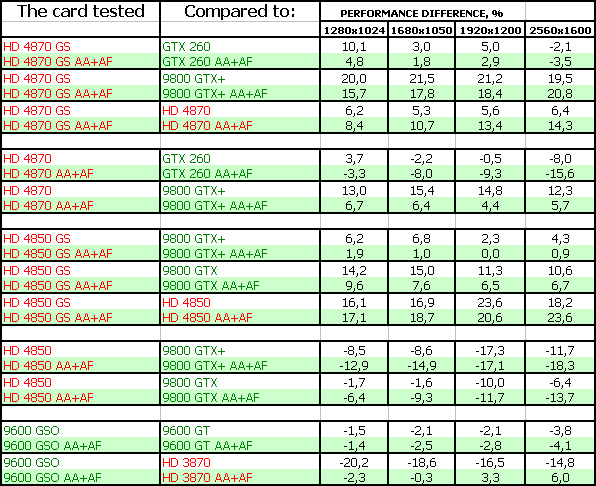 Company Of Heroes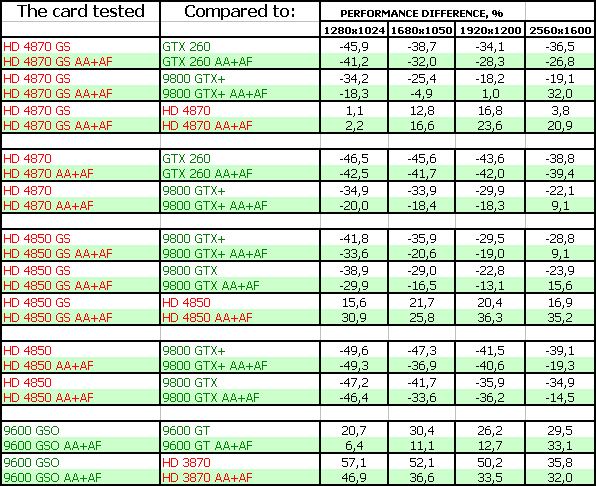 3DMark Vantage, Graphics MARKSPerformance charts: 3DMark Vantage, Graphics MARKS 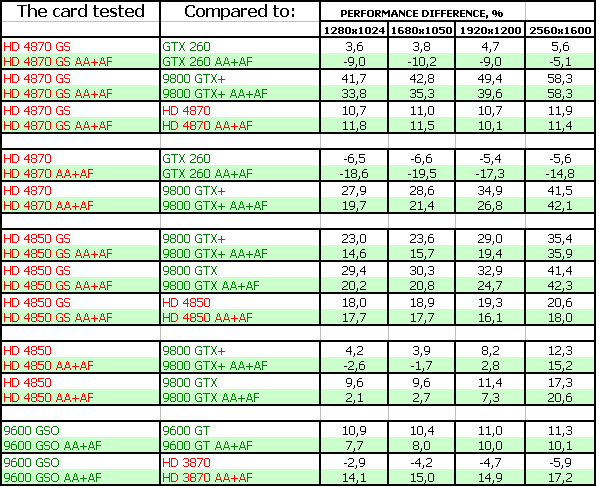 Devil May Cry 4, SCENE1Performance charts: Devil May Cry 4, SCENE1 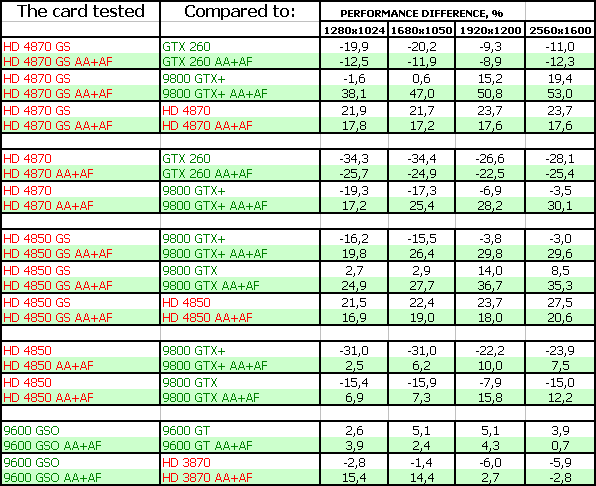 Devil May Cry 4, SCENE4Performance charts: Devil May Cry 4, SCENE4 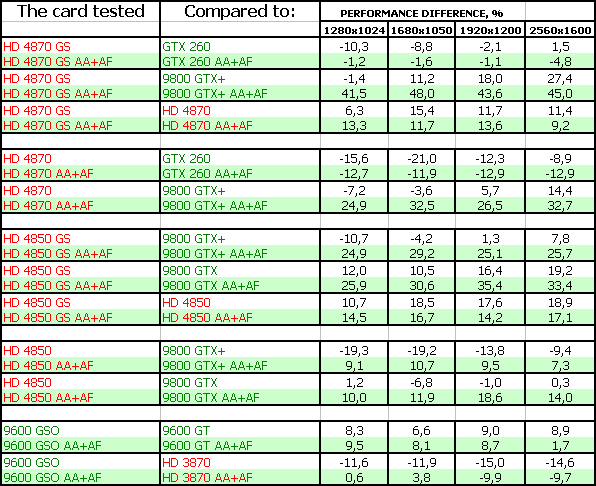 ConclusionsYou may have noticed that the situation around 4870 cards has changed since our baseline review. Firstly, NVIDIA slightly improved performance of GTX cards. Secondly, they became cheaper. It seems that the current situation is beneficial for 4870 products. We can see that only the overclocked 4870 card performs on par with GTX 260 almost in all tests. But GTX 260 is still more expensive than 4870. Besides, 4870 has a great price drop reserve, while GTX 260 -- PCB of GTX 280, 512-bit bus (448-bit used), huge amount of memory and a very expensive GPU -- with its current price tag is balancing on the verge of profitability. So, in my opinion, 4870 products will have more opportunities in the future, because you can already buy one for less than 300 USD, which will hardly happen to GTX 260 while they are still manufactured (we are talking about our local market). Of course, the market needs more 4870 cards with 1 GB of memory to overcome the last advantage of GTX 260 cards, i.e. large memory volumes. It's no secret that modern games devour memory even at moderate resolutions. As for 4850 and its modifications, it's a perfect choice. This product offers an excellent price-performance ratio, considering that even 9800 GTX price will never drop down to the 4850 level, to say nothing of 9800 GTX+. A couple of months ago I said that we would see 9800 GTX cards at the promised 199 USD in the Russian market only after its discontinuance. So 4850 cards have great prospects. Regardless of memory volumes and frequencies, 9600 GSO is still a very strange solution from the marketing point of view. It shares the market segment with 9600 GT and offers more or less similar performance. I understand that it's the only way to sell G92 rejects, pared down from 128 to 96 processors. But they could have thought out frequencies and other features to provide some performance difference from 9600 GSO (former 8800 GS) and 9600 GT. Gainward HD 4870 Golden Sample 512MB is a very good product in terms of both performance and cooling. It also has a good PCB layout, including the location of additional power connectors. But the bundle is very poor. Mind you, times of OEM bundles in retail are long over. Gainward HD 4870 512MB is a reference card with all respective pros and cons. The bundle is also poor. Gainward HD 4850 Golden Sample 512MB has an excellent price-performance ratio, considering how difficult it is for the competing company to cut prices. Significantly increased frequencies provide big bonuses to this card. But its bundle is also very poor and that somewhat spoils the overall image. Gainward HD 4850 512MB is not as attractive as the previous card, but it's still a very good product in terms of price and performance. Also has a very poor bundle. Gainward Bliss 9600 GSO Golden Sample 768MB is a slightly improved 9600 GSO 384 MB. It performs well comparing to 9600 GT and the competing card from AMD. Sometimes it even manages to provide the optimal price-performance ratio. The "strangeness" of 9600 GSO is related to marketing only. For users it may be a good choice, provided the price is adequate. Its bundle is even a tad better than those of the previous cards. On the whole, Gainward's debut as a manufacturer of AMD-based cards is a success. The company offers a good choice of interesting customized products. AfterwordA few words about our benchmarks. In our updated FRAPS review we have illustrated how crude and inaccurate tests with this utility are. Testers do not have other tools, except for benchmarks built into games. This article and its first part explain that it's sometimes possible to test games with integrated and identically looped demos. Although this implies lots of potential errors, since measurement accuracy depends on a given tester: whether he starts/stops FRAPS in time or does it too late/early. But I have run across situations, when demo load changes abruptly in the very beginning or end. So a half-second delay in starting/stopping the utility changes the average FPS by 15-20%. That's not a measurement error anymore - such a test is a total waste of time. One time you delay the test, another time you start it too early (not intentionally, of course), and you end up with absolutely different performance results. But even that's not the most important thing. The fact is, there are almost no games with built-in demos anymore. So, testers are forced to use a method that we deem totally unacceptable. They measure gaming performance by walking a straight line from the a starting point in a scene to a selected destination (the nearest fence, tree, etc.). We all understand that it's impossible to navigate to a finish spot in precisely the same route with different cards and in different resolutions. Besides, such games always introduce random elements into a scene, and objects may be placed slightly differently on the same scene. Unfortunately, websites that publish a huge number of tests do not always reveal their test methods for each game (except for those with built-in benchmarks). So, we believe that it's better to offer a limited number of game tests, but each will be crystal clear, accurate and showing actual differences between graphics cards. We express gratitude to Gainward for provided graphics cards.
PSU provided by TAGAN, monitor provided by NVIDIA. Write a comment below. No registration needed!
|
Platform · Video · Multimedia · Mobile · Other || About us & Privacy policy · Twitter · Facebook Copyright © Byrds Research & Publishing, Ltd., 1997–2011. All rights reserved. |